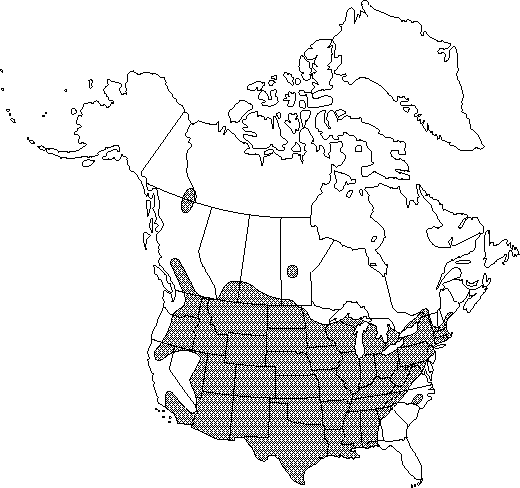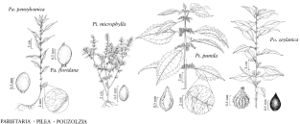Parietaria pensylvanica
Sp. Pl. 4(2): 955. 1806.
Herbs, annual, 0.4-6 dm. Stems simple or freely branched, decumbent, ascending, or erect. Leaf-blades narrowly to broadly elliptic, lanceolate, oblong, or ovate, (1-) 2-9 × 0.4-3 cm, base narrowly cuneate, apex acuminate to long-attenuate or obtuse to rounded; proximal pair of lateral-veins arising above junction of blade and petiole. Flowers: involucral-bracts 1.8-5 mm, usually less than 2 times length of achene; tepals 1.5-2 mm, shorter than bracts. Achenes light-brown, symmetric, 0.9-1.2 × 0.6-0.9 mm, apex obtuse, mucro apical; stipe straight, short-cylindric, centered, basally dilated. 2n=14, 16.
Phenology: Flowering spring–late fall.
Habitat: Dry ledges, talus slopes, waste and shaded places, primarily in neutral to basic soils, and reported from margins of hot springs in northernmost locations
Elevation: 0-2400 m
Distribution

Alta., B.C., Man., Ont., Que., Sask., Yukon, Ala., Ariz., Ark., Calif., Colo., Conn., D.C., Fla., Ga., Idaho, Ill., Ind., Iowa, Kans., Ky., La., Maine, Md., Mass., Mich., Minn., Miss., Mo., Mont., Nebr., Nev., N.H., N.J., N.Mex., N.Y., N.C., N.Dak., Ohio, Okla., Oreg., Pa., S.C., S.Dak., Tenn., Tex., Utah, Vt., Va., Wash., W.Va., Wis., Wyo., Mexico
Discussion
Some extremes of Parietaria pensylvanica with short, oblong or ovate leaf blades strongly resemble P. hespera var. hespera. Parietaria hespera is usually more delicate and has thinner leaves with the proximal pair of lateral veins arising at the junction of blade and petiole. Leaf shape and texture tend to overlap in the two species, but in P. pensylvanica the proximal pair of lateral veins clearly arise above the junction of blade and petiole. The extremes of P. pensylvanica frequently are found where the ranges of the two species approach or overlap. Examples of these intermediates are from Gila, Mohave, and Yuma counties, Arizona. A mixed collection from Rock Springs, Gila County, Arizona, suggests that the two species occasionally grow together.
Selected References
None.
Lower Taxa
"-2timeslengthofachene" is not declared as a valid unit of measurement for this property.
